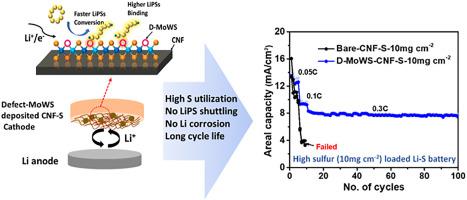Journal of Power Sources ( IF 8.1 ) Pub Date : 2021-09-01 , DOI: 10.1016/j.jpowsour.2021.230426 Sanket Bhoyate 1 , Bumsu Park 2 , Sang Ho Oh 2 , Wonbong Choi 1, 3

|
Despite of high theoretical energy density, the practical application of Li–S battery (LSB) is limited by its intrinsic hurdles such as lithium polysulfides (LiPSs) shuttling effect and limited sulfur loading and its utilization in cathode. Here, we develop a defect engineered MoxW1-xS2-y alloy catalyst (D-MoWS) deposited on carbon nanofiber (CNF) via a facile hydrothermal synthesis followed by a thermal-solvent vapor etching method to expedite the LiPSs redox kinetics and resolve the limit of sulfur utilization in LSB. The LSB cells assembled using the D-MoWS–CNF–S cathode show the highest specific capacity of 1586 mAh g−1 and excellent areal capacity up to 13.5 mAh cm−2 at high areal sulfur loading of 10 mg cm−2, resulting in the highest energy density of 1090 Wh kg−1 (w.r.t total weight of anode and cathode). Our mechanistic study and ex-situ SEM analysis prove that D-MoWS catalyst accelerates the LiPSs conversion, prevents the shuttling effect and Li-metal corrosion, therefore, effectively reduces the negative/positive electrode capacity (N/P) ratio to the lowest reported value of 1.7.
中文翻译:

缺陷设计的MoWS合金催化剂促进锂硫电池中的多硫化物转化
尽管理论能量密度高,但锂硫电池 (LSB) 的实际应用受到其固有障碍的限制,例如多硫化锂 (LiPSs) 穿梭效应和有限的硫负载及其在正极中的利用。在这里,我们开发了一种缺陷工程 Mo x W 1-x S 2-y合金催化剂(D-MoWS),通过简单的水热合成和热溶剂气相蚀刻方法沉积在碳纳米纤维(CNF)上,以加速 LiPSs 的氧化还原动力学并解决 LSB 中硫利用的限制。使用 D-MoWS-CNF-S 阴极组装的 LSB 电池显示出最高的比容量 1586 mAh g -1和高达 13.5 mAh cm -2 的优异面积容量在 10 mg cm -2 的高面积硫负载下,产生最高的能量密度 1090 Wh kg -1(与阳极和阴极的总重量相比)。我们的机理研究和非原位 SEM 分析证明 D-MoWS 催化剂加速了 LiPSs 的转化,防止了穿梭效应和锂金属腐蚀,因此,有效地将负/正电极容量 (N/P) 比降低到最低的报道值 1.7。











































 京公网安备 11010802027423号
京公网安备 11010802027423号